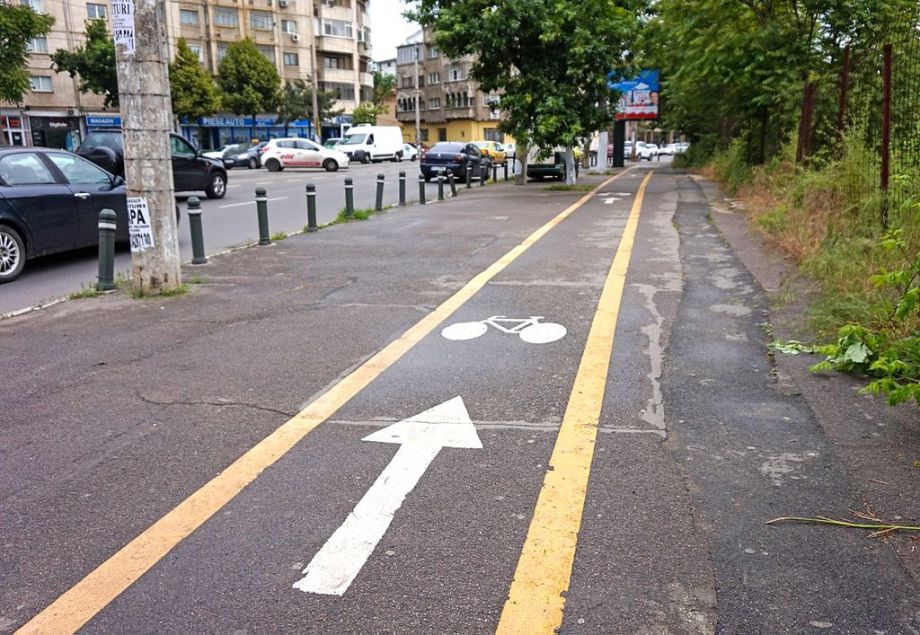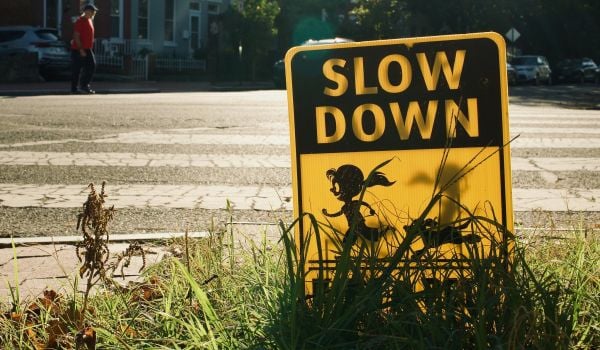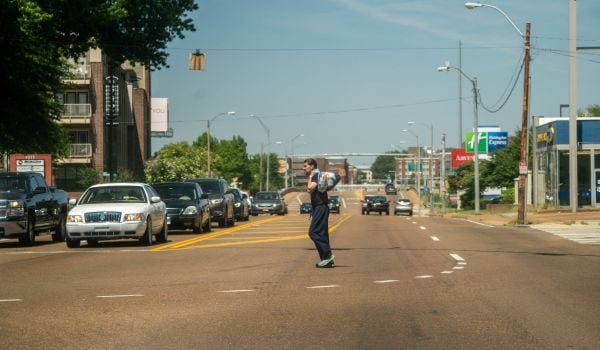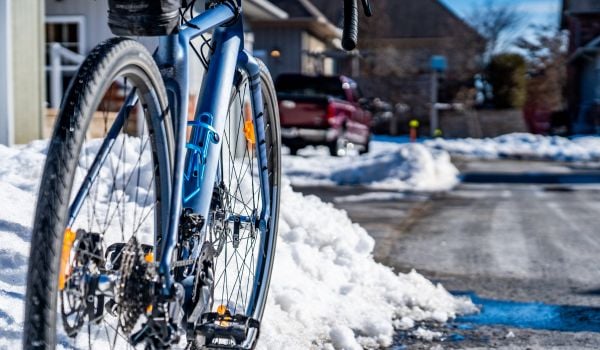Every time she goes to the wet market, Elena Năstase feels like she’s on an adventure.
Because of her neuromuscular disease, Năstase needs a powered mobility scooter to help her move around town. She chooses routes with lots of small streets, far away from congested boulevards, and makes her way on the narrow sidewalks – upon which cars illegally park.
“Every time, I face extraordinary risks,” Năstase says. “Few sidewalks are accessible to us, and even those that are accessible, still have some sharp edges that put your life in danger. It’s not a smooth transition as it should be.”
When there’s no way on the sidewalk, she must ride her scooter on the driveway, equipped with a reflective vest. Some drivers aggressively overtake her. Others honk at her.
That’s a 40-minute ride. If there were bicycle lanes, she would get to the market in 20 minutes, safe and relaxed.
“It’s crucial for any disabled person to be independent,” she says. “Some bike lanes would be so useful. Inclusion without accessibility can’t exist.”
In a city that boasts 1.2 million registered cars, 2.4 million citizens, the EU’s highest pedestrian mortality rate and some of its most polluted air, there are voices asking for years for a paradigm change in Bucharest: safe access on the streets and sidewalks for pedestrians, cyclists and people with disabilities.
And now, after more than 10 years of advocacy and lobbying from NGOs, activists are seeing signs of progress. Just this summer, the mayor of Bucharest, Romania, announced that several major streets would include sharrows, painted signs on the driveway which means cars will share the road with bicycles.
Building a movement
Marian Ivan is the president of the Organization for Promoting Alternative Transportation in Romania, or OPTAR. He himself has been advocating for more than a decade.
“You can’t talk about bicycles without understanding the needs of the other categories of traffic participants,” he says.
Ivan learned how to ride a bicycle at 39 years old. Back then, in 2010, he could barely spot any other cyclists on the streets of Romania’s capital. The bicycle lanes were then on narrow sidewalks, leaving both cyclists and pedestrians feeling unsafe. Obstacles such as trees, pillars, benches or potholes were often situated in the middle of bicycle lanes.
Soon, Ivan started to organize major protests – group bike rides on the main streets of Bucharest. Twice a year, the bikers join forces to demand that the municipality, the government and corporations develop proper bike lanes, bike parkings and a biking community.
In the first such rally, held in 2012, he figured he would be lucky to get 100 attendees. 1,200 showed up.
Since then, more and more people in Bucharest have become interested in alternative transportation – the record at Ivan’s protests is 5,000 participants. But people still were telling him they don’t feel safe biking outside of these large protests.
Nine cyclists per million inhabitants are killed each year in Romania, per a report by the European Transport Safety Council, as compared to fewer than two cyclists per million in Spain and the UK. The only country that exceeds Romania in cyclist deaths is the Netherlands, which sees 12 cyclist deaths per million inhabitants – but the report notes that in the Netherlands, on average, residents bike an average of 865 kilometers annually, suggesting 13 cyclist deaths per billion km biked.
Even more alarming, serious road traffic injuries of cyclists is increasing by an average of 9% annually in Romania, the report notes.
OPTAR has put together a detailed document explaining how Bucharest should develop bike infrastructure to help protect cyclists. Ivan’s group offered it for free to the local administration. So far, it hasn’t been used.
In Bucharest today, there are only 32 kilometers, or less than 20 miles, of bike lanes (for comparison, Paris has about 1,200 kilometers of bike lanes). Most are on the roadway, endangering cyclists, or on the shared narrow sidewalks, endangering pedestrians.
“Bucharest is a chaotic city, and it’s a miracle that it works,” says Iulia Dorobanțu, a local urbanist architect. “Cars have taken over the space, and the authorities don’t prioritize using other means of transportation.”
Slow, steady progress
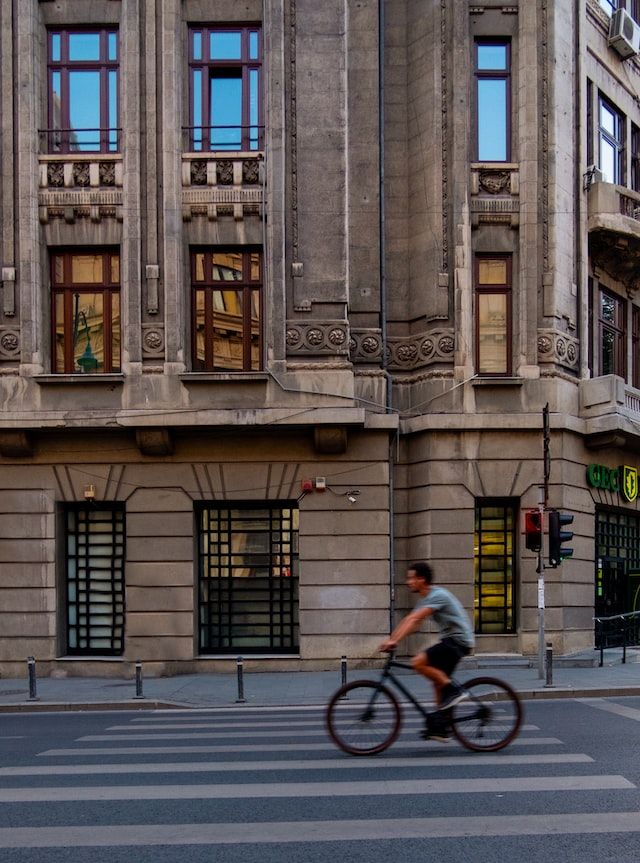
A cyclist in Bucharest. (Photo by Sheriseeeee / Unsplash)
After a decade of advocacy for safer and more accessible streets, results are showing up.
A proactive biking community has formed to agitate for cyclists’ safety and rights. Most of the city’s bike lanes – built on the sidewalks, and with mistakes in design and construction that made them hazardous to cyclists – were declared illegal a decade ago thanks to this community’s advocacy. For the first time in the history of Romania, there is a department for bicycle infrastructure at the Ministry of Development. NGOs are being consulted for changes in legislation and for new projects.
And solutions proposed by NGOs are slowly beginning to be considered by the local administration.
In July, Bucharest mayor Nicușor Dan announced that several major streets would include sharrows to encourage people to commute to work by bike instead of car. These painted signs on the driveway mean that cars and bikes will share the road, acknowledging that bikes are legitimate transport vehicles.
At the end of 2021, a major bike safety law was approved: A cyclist must be given enough space on the road to be safe, basically treated like any other car. Drivers who fail to follow the rule can lose their license.
In the center of the city, the speed is limited to 30 kilometers per hour (about 19 miles per hour). During the summer weekends, some streets are closed to traffic and open to people.
In 2015, the only proper bike lane was built, after organizations including OPTAR pushed for change. About 14,000 cyclists are using these 3 kilometers of the road every month.
Following a survey of 20,000 kilometers of Southeastern European roads that revealed serious cyclist safety issues, the European Union co-funded a 30-month project focused on road infrastructure safety for cyclists in Romania and 13 other Southeastern European countries. The nonprofit Sabrina Project – Safer Bicycle Routes In Danube Area – is working to improve cycling infrastructure safety issues on existing, planned and missing cycling corridors in the region through the end of the year.
But turning Bucharest from a city of cars into a city for everyone, bikers and pedestrians included, is a difficult endeavor. And change happens slowly.
“The authorities listened to us probably because the European Union told them Romania is not a safe country for visitors,” says Oana Turturică, volunteer at Hai cu Bicla non-profit, another organization that pushes for safer roads for bikers. “Foreigners who bike around the city are putting themselves in great danger.”
Hai cu Bicla won during a round of participatory budgeting funds, which allow citizens to vote on specific projects and decide on what their taxes should be spent on. Now the municipality must follow their suggestions and build sharrows, bike parking and bike repair stations.
But so far, these solutions have not seen success. Officials bought 500 bike racks – but they turned out to be the wrong ones. Riders can’t park a scooter or small bike there, because one of the metal bars is too high. Now, Turturică has to write an official letter to the municipality and ask for another type of bike parking.
“That’s not what people voted for, that’s not what I suggested in the project,” Turturică says.
But NGOs can change a city, even if only piece by piece. Turturică learned that lesson in the summer of 2017.
Back then, people were using a dangerous passage to get from one part of the biggest park in Bucharest to another. They had to climb a difficult hill and then cross an electric railway. Many accidents happened, and many people died. Hai cu Bicla advocated for a floating pontoon to connect the two parts of the park. Then, for the first time in a century of the existence of the park, disabled people could surround the whole park’s lake. And kids, mothers with strollers, and bicyclists benefit from it, too.
Turturică says it’s crucial that NGOs promoting alternative transportation have patience and talk to all stakeholders, regardless of the political party supporting them.
“Ask them to imagine themselves not being bikers, but kids, toddlers – because when they are in the stroller, they are closer to the exhaust pipe,” she says. “You have to make them understand that, in the end, everyone wants safe driveways and no more victims or dead people.”
Oana Racheleanu is a journalist in Romania covering environmental issues.

